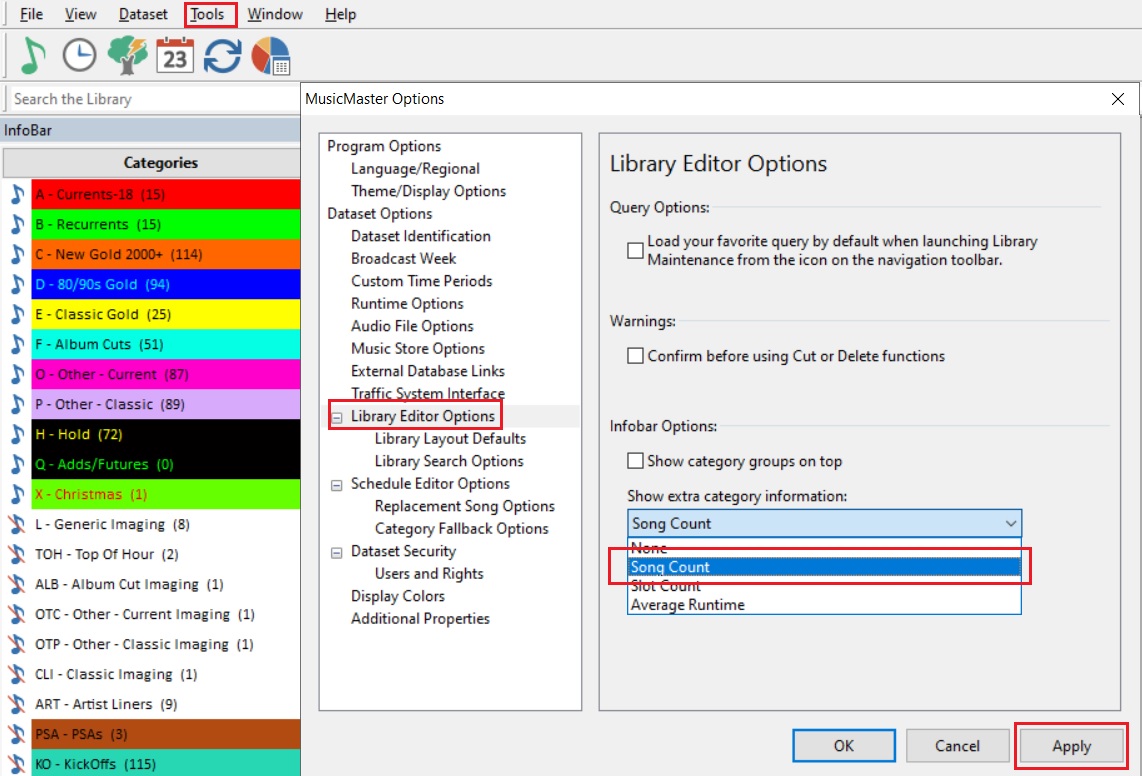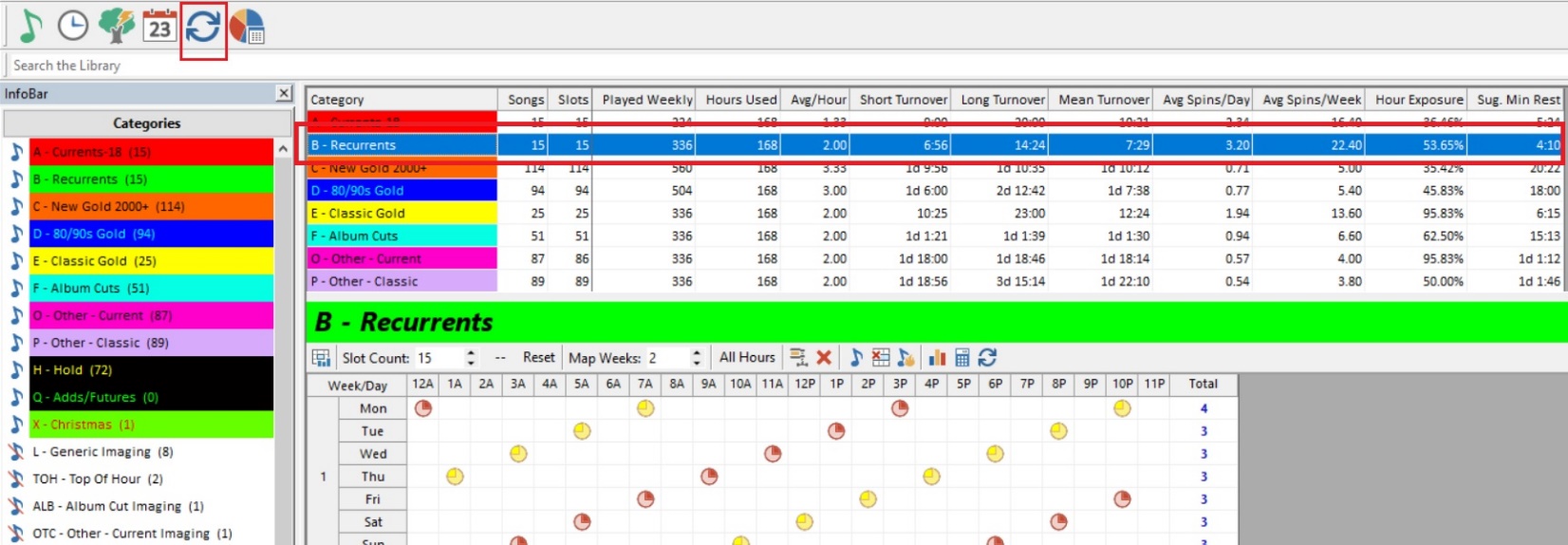MusicMaster Blog
Does Size Matter? posted on February 16th, 2023
By Dave Tyler
I get asked quite often about how large or small a music database should be for a successful station. It is an interesting and very broad question for sure. The easy answer is: I don’t know, what are you trying to accomplish? In this article, we will start from the science of creating a database playlist size and wind our way to a more philosophical look at having a small or large playlist.
A hot CHR might have a very small and tight database, while a streamer or local station might have a very broad playlist, and a Classical programmer may have 200,000+ pieces easily. There is no right or wrong size, only “What size most efficiently accomplishes your sound goals?”
Let’s get to the foundation of any station: Categories, Category Song Counts and Clock calls. These three things determine our “Turnover” or how long or soon it takes for the category to play each song once before the same songs play again on the schedule.
Let’s break it down further. When creating categories, you can think of them as folders where you store songs. Keep in mind that the categories you will use in your “Active” clocks/grids need to be thoughtfully considered because the amount of songs (Song Count) directly affects how quickly a song will play, rest and come back to play again, or turnover.
Clock calls are the final deciding factor on how Turnover will play out. As a simple example, if I have a HOT category with 6 songs in it (Song Count) and that category is used in each clock one time (Clock Calls) then my turnover will be every 6 hours. As another examples, if there were 24 songs in the category and the clock called for that category once per hour, it would take 24 hours to go through the entire category and in other words, each song would play would play once every 24 hours.
By the way, did you know you can see your Song Count without having to open the category? It is easy to set up. Go to Tools/Options/Library Editor Options and choose “Song Count” from Info Bar Options. (Pic below)

Going back to the start of Top 40, could you imagine having a playlist of just 40 songs? That is a tight rotation, but is it wrong? Again, there’s no right answer but if the goal was to play the newest songs that folks wanted to hear the most, then it is spot on. Of course, once a song falls off the list well…people still want to hear it sometimes. That’s the purpose of Recurrent and Gold categories. So, a small fast rotating “Currents” category(s) supported by larger but carefully curated, slower turning over Recurrent/Gold categories made a lot of sense. Give the people what they want, because like the old saying goes “Every song is a three minute opportunity to either keep a listener or have them switch to your competition.”
In MusicMaster, we have a couple of amazing tools that will show you what your turnover actually looks like. In the main toolbar, click on that icon with the two blue arrows in a circle…that is Turnover Analysis. When you click on this you get a full suite of information about how your categories plot, turnover, and move. In the example below, looking at the Recurrent category for this database, you can see there are 15 songs in the category playing an average of two per hour. The Short Turnover for this category is 6:56, the Long 14:24 and the Mean or Average is 7:29. Below that is a chart that gives an example of how one song in that category, not a specific song but how any song in that category would move. This is before rules come into play. Here you can see how the larger categories, even those with more Clock Calls, turnover slower because the song count is much higher.

Now let’s look at that New Gold 2000+ category. It shows an average of 3.33 plays per hour. How can that be? Well if we click on the Format Clock Category Usage button (Clock Calls) we can see that they never actually have three calls for this category in any hour, it’s either two or four. But this averages out to 3.33. This too is a good place to gather up information when trying to determine where you want to be, what you want turnover to be, and how many songs vs how many clock calls will get you there. In short: to get a category to turnover faster, you can either have a smaller category or more clock calls. To get a category to turnover slower, either make it larger, or use it less often in the clock. It’s a balancing act to get you where you want to be!

Now let’s go to the philosophical side of things. How much music is too much music? Should I only schedule songs that are released by the labels and adhere to the Industry charts? What if I want to play deeper cuts off an album, would that make sense? Heck in the 70s with FM radio starting to get its feet under it, there was an entire format dedicated to that! AOR Album Oriented Rock! It’s one of the most well-known pieces of rock trivia that Led Zeppelin’s “Stairway To Heaven” was NEVER released as a single but it is arguably their most popular song by a long way and had us dashboard drumming years before “In The Air Tonight” or “Jack and Diane”! Why was AOR successful for it’s time? Perhaps we listened to music differently. When I would get an album I would go home, put headphones on, pull the liner notes or lyrics out, and listen to the whole album. Because a lot of people my age did that, maybe folks kinda knew the music already. We had heard the entire piece of work, not just the songs that would become singles. As a life long radio guy, I think I can listen to any album from any format that I’ve played over the years and find at least one song that I cannot believe never got radio play. I bet you can too!
The way we listen has changed since the iPod and then Spotify and Amazon etc. Like most radio people, my musical interests and likes are broad. I have playlists that include everything from Patti Page to Powerman 5000 (NOT on the same list!) and there is a LOT in between those two! I am a Singer/Songwriter ballad junkie and I have a cousin who is constantly sending me the greatest acoustic performances by people you’ve never heard of. Dylan, Carole King, John Prine level songwriting that most will never hear.
What are the main formats out there? Urban, CHR, Country, AC, Classical, Jazz and Rock. But then, think of all of the formats that have branched from these…the “Alt” formats of each mentioned above that were created to introduce us to folks outside the box. Heck, Americana may be the Godfather of these formats. It might be fair to say that a lot of these are run by Universities that have funding to support a lesser known more ambitious format, as opposed to having to serve the masses and hustle for advertising dollars, and maybe for that reason can take the risk.
I think music lovers/listeners are much more open to new sounds than ever before and are willing to give deeper, unknown artists/songs a chance. At the end of the day, we can ask our phones to play any song we want to hear on the planet when we tire of the unknown and want to hop back into our comfy place. Some stations with tight playlists have feature programming later at night or on the weekends that might show off some of these incredible fringe performances and the people who are interested can tune in at this specific time.
I work frequently with a Programmer who believes 300 actively rotating songs is the max for a Country station and 200 would even be better and 150 better still. On the other side of things, I have a client with a massive library that literally has every song from the artists they play. All the hits and all of the album cuts, and they rotate equally with the goal being that every song will play before the list starts over. Which one of these programmers is correct? To bring it full circle, they both are if they are accomplishing their goals. One may be feeding listeners nothing but the hits while the other aspires to broaden their listeners by presenting tunes they likely have not heard before or going for variety. Goals being met = success, whatever those individual goals may be.
A Streamer might focus on a feel or vibe while a terrestrial station picks a format and does just that and keeps it simple but good. A “Hobbyist” on a stream has the incredible freedom to play anything they want, while the PD of several stations has a bottom line because this is a business. I run a pretty tight playlist but I am also a big fan of my “Variety” or “Oh Wow” category of songs that go pretty deep but are all well known songs that just kind of went away. I use it sparingly but love the idea of a listener going “Dang I forgot about that song!”
At the end of the day, the playlist size that is right for you is up to you and will likely change as you change. From huge playlists that take months to turnover to tight lists that keep the hits in the ears of your fans…we can help you with both. Just let your Music Scheduling Consultant know what you are looking to do and we’ll work with you to make it happen. That great radio in your head can come out of the speakers. Let’s get to work!

